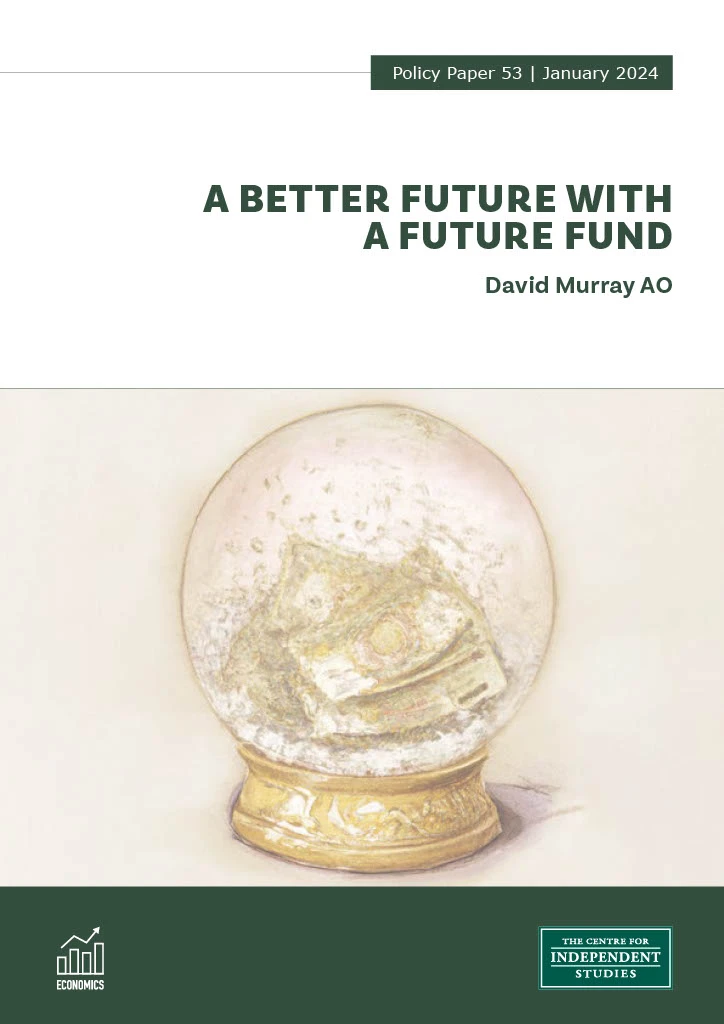

The Future Fund was established in 2006 to strengthen Australia’s long term financial position in response to the first Intergenerational Report by the Treasury and the government’s very strong fiscal position. Its mandate was to invest budget surpluses and proceeds of asset sales to offset its unfunded superannuation liabilities and to address pressure on future budgets from ageing of the population – then likely to arise from 2041 onwards.
Many countries have established sovereign wealth funds, mostly at the outset to preserve wealth for future generations in the face of resource depletion, predominantly oil. With $205bn of assets ($255bn including the ancillary funds), Australia’s Future Fund ranks 19th amongst world’s top 100 funds listed by the Sovereign Wealth Fund Institute.[1]
Future Fund: scope and mission
The Future Fund has a clear public accountability framework, which is consistent with international best practice. For example, its long-term objective is consistent with a target return of inflation plus 5% (reduced to 4.5% by the government in 2017).
I recall some international colleagues counseling me that a return with that stretch could result in excessive risk taking, however the outcome has been very successful. Target returns have been exceeded without excessive risk, the fund is transparent and accountable to government, and there have been very limited calls to withdraw funds or mandate inveting for special causes.
The Future Fund was formed by people with a strong sense of fiscal responsibility, and a superior sense of intergenerational equity.
Attacks on the Future Fund without due regard for all the facts and proper context give rise to populist pleas to use the money for favourite causes — and distract debate from the issues underlying the national fiscal deterioration since the fund’s inception and what sensible policies might be considered. Often these attacks are infused with an unrealistic optimism of the likelihood of success of alternative proposals. For example, liquidation, as suggested by Dimitri Burshtein, is likely to cost the taxpayer an estimated $200 billion over the next 10 years, on the best available estimates.
This paper will set out the positive case for the Future Fund, arguing why Australia is better off having a Future Fund. It will then examine and refute the arguments against the continuation of the Future Fund and address the issue of whether the Future Fund is a sovereign wealth fund after all.
Rationales for a sovereign wealth fund
Fernandez and Eschweiler provide four broad rationales for the establishment of a sovereign wealth fund.[2] These include:
- Revenue stabilisation funds are designed to cushion the impact of volatile commodity revenues on the government’s fiscal balance and the overall economy.
- Future generation (savings) funds are meant to invest revenues or wealth over longer time periods for future needs. The sources of these funds are typically commodity based or fiscal. In some cases, these funds are earmarked for particular purposes, such as covering future public pension liabilities.
- Holding funds manage their governments’ direct investments in companies. These may be domestic state-owned enterprises and private companies as well as private companies abroad. Holding funds typically support the government’s overall development strategy.
- Generic sovereign wealth funds often cover one or several of the previous three purposes, but their size tends to be so large that the main objective becomes optimizing the overall risk-return profile of the existing wealth. These funds often manage part of the “excess” foreign reserves.
Why Australia should have a Future Fund
There are four arguments in favour of a Future Fund. First, Australia has very considerable natural resources relative to its population size and continues to benefit from price booms generating government revenue. Depletion of these resources is best managed by reserving savings for future generations and this can only be done through long term patient investment.
Second, returns from this form of investment, given its risk/reward stance, will be higher over the long term than the government’s cost of funds. While this could change in materially adverse circumstances, the experience has been positive given the performance of the Fund since inception through the Global Financial Crisis and the Covid pandemic.
Third, the existence of such funds requires continual examination of fiscal policy trade-offs for the community. For example, a budget stabilization fund requires an agreed formula for determining conditions for deposits and withdrawals — a de facto long-term budget framework. Whether this would work is debatable, as government remains susceptible to boondoggle projects and generous support programs. During the Global Financial Crisis, a number of funds with less rigid mandates than the Future Fund were required to make unexpected contributions to government, causing them to cash in assets at the time of market price weakness.
Fourth, well established and run funds give rise to confidence among foreign investors. The Santiago Principles, adopted by the world’s most prominent funds in 2008, provide (refer GAPP3) that a fund’s activities should be closely coordinated with domestic fiscal and monetary authorities to ensure consistency with the overall macroeconomic policies. In Australia’s case, such policies need to take account of resource and foreign investment dependency by maintaining confidence among foreign bondholders and investors. Historically, Australia has done this through fiscal discipline and having a strong credit rating. If this continues, the Future Fund should be successful.
Above target returns
Another strong argument in favour of the Future Fund is that the returns have generated income that would not otherwise exist. An unexpected advantage of having the Future Fund is that at times like this, it requires us to examine policy options and consequences in a world where governments have allowed people to believe that bonds can be issued (and even purchased by their own central banks) without longer term consequences.
Is the Future Fund a sovereign wealth fund?
Questions have been raised by some critics of the Future Fund as to whether it is in fact a sovereign wealth fund or not. While it is not clear whether anything turns on this issue — the governance and operation of the fund is set out in law and would not change regardless of the classification of the fund — the argument that the Future Fund is a sovereign wealth fund is far stronger than the reverse.
Fernandez and Eschweiler define sovereign wealth funds as “special government asset management vehicles which invest public funds in a wide range of financial instruments.”[3] They go on to note that this definition is broad; the accepted classification of government funds is not always as clear cut. However, they note that Australia’s Future Fund is generally regarded as a sovereign wealth fund, even if it does have some characteristics in common with state owned pension schemes that are not regarded as sovereign wealth funds.[4]
The Santiago Principles were adopted by the world’s sovereign funds in 2008, with considerable input from Australia and are followed by the Future Fund. They define Sovereign Wealth Funds as special purpose investment funds or arrangements that are owned by the general government.[5] The Santiago Principles identify three key elements that define a sovereign wealth fund (SWF):
- Ownership: SWFs are owned by the general government, which includes both central government and subnational governments.
- Investments: The investment strategies include investments in foreign financial assets, so it excludes those funds that solely invest in domestic assets.
- Purposes and Objectives: Established by the general government for macroeconomic purposes, SWFs are created to invest government funds to achieve financial objectives, and (may) have liabilities that are only broadly defined, thus allowing SWFs to employ a wide range of investment strategies with a medium- to long-term timescale. SWFs are created to serve a different objective than, for example, reserve portfolios held only for traditional balance of payments purposes. While SWFs may include reserve assets, the intention is not to regard all reserve assets as SWFs
They exclude funds or assets managed for the benefit of individuals. That is, they are held in the shared interest of the whole community. Here is a crucial distinction between SWFs and superannuation funds. If the Future Fund were a superannuation fund it would have members or beneficiaries who would be entitled to its assets upon liquidation.
Ironically this means that if the Future Fund was actually a superannuation fund and it was liquidated as some critics have recommended, the monies could not be applied to reduction of government debt as hoped.
Why then was the Future Fund model focused on the superannuation liability rather than being characterised simply as an intergenerational wealth fund?
In 2006, when the Future Fund was established, the Commonwealth had negative net debt – this is one of the reasons for the establishment of the Future Fund itself. There was a robust debate at the time about application of surpluses, for example infrastructure spending versus intergenerational savings. The government also had a focus on the substantial costs of ageing and the attendant risks to intergenerational equity.
One obvious reason is that, despite the absence of debt, the government did have unfunded liabilities and easily the largest (and growing) item was future public superannuation commitments for which no provisioning had ever been made from recurrent revenues and which was projected to grow to $140bn by 2020.
Peter Costello’s book, The Costello Memoirs, points out the intergenerational inequity in the historical failure to provision for superannuation liabilities on an as you go basis — the notion that the current generation had to play catch-up on past generation’s debts. This was at a time when the private sector was being held to account for fully funding such liabilities and the states had commenced progressive catch-up funding.
In other words, Costello was pointing to the inconsistency in addressing the looming intergenerational challenges without first repairing the past intergenerational shortcomings. True to his position, Costello legislated that once the past liability was met, the Fund would then pay out each year the incremental liability for that year.
None of this could be taken to mean that the Fund was a superannuation fund. The related rules did, however, mean that the fund did have a clear investment horizon and withdrawal rules. The government augmented these with a return mandate of inflation plus 4.5 to 5.5%pa over the long term, giving it the clearest mandate among sovereign wealth funds globally.
Issues confronting the Future Fund — do they justify drastic change?
The CIS research paper A Future Without Future Funds by Dimitri Burshtein points to the significant changes in circumstances since the establishment of the Future Fund. While his criticism is one of the more recent, it is not the only such claim. Many critics have suggested we should cash in the Future Fund, change its investment mandate or otherwise fundamentally change the nature of it.
Some of these critics fail to understand critical facts about the rationale for its establishment, the reason for its structure, the nature of the fund and its ancillary funds, and a proper discussion of the pros and cons of options in the current economic environment.
Burshtein quoted Nobel laureate Paul Samuelson ‘’When the facts change, I change my mind.’’ This quote omits the final sentence “What do you do?” Surely we reassess according to the original objectives, intervening events, and current circumstances. What we should not do is to use the changes in facts to justify an original position which opposed the objectives without saying why.
What is more disappointing is the emergence of political freeloaders wanting pet projects and more net debt on the back of the article and criticism of the fund which has turned out to be an Australian institutional asset highly regarded around the world.
Unfunded super liabilities and the opportunity cost of the Future Fund
As Burshstein points out, the unfunded superannuation liabilities increased to $408bn by 2021, and the Commonwealth’s debt increased very substantially to $550bn by 2023. This simply means that whereas the Commonwealth did not have any debt to repay in 2006, it does now. Further, there are additional liabilities to be covered.
The reality is that since inception of the Future Fund, public sector superannuation liabilities have grown at a compound annual rate of over 8%pa and Commonwealth government securities on issue have increased from 5.4% to 34.9% of GDP gross debt — both growth rates higher than trend nominal GDP.
Notwithstanding the growth of Future Fund and superannuation fund assets offshore, we remain in deficit to the rest of the world with net foreign liabilities of 33% of GDP. Our dependency on foreign capital remains a vulnerability in times of stress and needs to be managed by retaining a strong credit rating to give foreign creditors confidence. Loss of our rating raises the cost of debt to governments and banks, and ultimately home and business borrowers.
But the continued existence of these liabilities does not turn on the existence or otherwise of the Future Fund. Liquidation of the Future Fund would not extinguish unfunded superannuation liabilities, nor would it either result in a proportionate reduction in net debt or prevent future debt from accumulating.
If the Fund’s assets were transferred to public sector super scheme trustees, as advocated by Carling and Kirchner (2012) and Makin (2009), the defined benefit beneficiaries would have to agree to forego a Commonwealth guarantee of their benefits in exchange for a promise that the future value of the assets invested by the trustees would cover their pension. Presumably they would not exchange a superior guarantee for an inferior one.
The Parliamentary Budget Office (2019) concluded that net financial worth is a better indicator of sustainability of the fiscal position. As the Future Fund provides an important counterbalance to the government’s debt and unfunded liabilities its liquidation to create headroom for more debt would detract from net financial worth and weigh against Australia’s credit standing.
Keeping the Future Fund is an important, but not sufficient, condition for economic progress. We need to rein in public outlays and bloating of the public sector, reduce federal and state indebtedness, get inflation back to the target range and, most important of all increase productivity. These measures would take us back to the circumstances which led to the policy choice to have a Future Fund.
The better question is whether these measures would be more or less likely to occur if governments were given more fiscal breathing room through a one-off injection of funds from the liquidation of the Future Fund. It seems highly unlikely, given recent actions to create more leveraged investment vehicles, promote energy sector projects and subsidies with no hard-nosed cost benefit analysis, talk up projects like the Melbourne/Brisbane fast train, and do nothing to address declining productivity.
Risk and Future Performance
Modelling by the consulting actuaries Willis Towers Watson showed the expected added value of retaining the Fund relative to the alternative scenario of liquidation and debt retirement. They assume that the Future Fund makes a median return of 9.4%p.a. over the next 10 years, while the yield on government is 4.1%. These assumptions are based on historical experience and expert judgement. However, these returns are highly uncertain. Past experience suggests there is a one-in twenty chance that retaining the Fund would be less profitable than liquidation and a similar probability that the Fund would provide a net return greater than $500 billion. They concluded that the expected median value added over the next 10 years is around $200bn with only a 1 in 20 likelihood that there would be no material benefit.[6]
As the actuaries point out, the analysis is highly reliant on assumptions used for investment returns and yields which adopt a medium to long term horizon and therefore are not meant to reflect short term investment market movements. In reality forecasting is difficult and past performance should not be relied on as a reliable guide to future performance. We can be confident though that risk and return are positively correlated and a long-term mandate which allows for risk taking should be rewarded. One risk that needs careful consideration is sequencing risk where short notice of liquidation of the fund would lead to considerable losses from forced sale of assets in a potentially weak market. This has implications for the way in which policy options are considered, including timing.
Burshtein has applied only the latest year’s returns to frame a judgement about value and has judged that the ability to generate future returns above the Fund’s risk adjusted cost of capital or even its targeted rate of return will be increasingly difficult. On past experience, there is no justification for this type of prediction, it is just another person’s forecast. The Fund has had to navigate significant negative events since inception — and we know that returns to equity will over time outperform returns to debt. If we have the patience and model to operate the Future Fund, we should do it.
Should the government run leveraged investment vehicles?
While the Future Fund itself was established with a capital injection from budget surpluses, it is true that the ancillary funds managed by the Future Fund were set up with debt, and so in some sense represent government leveraged investment funds.
There is a stronger case to close these funds, as outlined by Burshtein in his piece. They represent a distraction for the Future Fund, based on their size and variations in investment mandates. The main criticism is that this type of fund can be used by government to finance popular programs in seemingly large sums off the budget whilst incurring more debt.
One exception is the Aboriginal and Torres Strait Islander Land and Sea Future Fund established on 1 February 2019 to assist Indigenous Australians to acquire and manage land, water and water-related rights so as to attain economic, environmental, social or cultural benefits. In effect, this is a vehicle for practical implementation of land rights proceeds for Indigenous Australians.
It was, until the report of an expert committee (which I chaired), severely constrained in its investment instruments thereby restraining its long-term returns and value to its beneficiaries. Its own Board felt more comfortable appointing the Future Fund as manager than running the distraction and risk of setting up their own investment systems and skills.
Market distortion and political influence
A large pool of publicly-controlled assets will inevitably be a tempting target for politicization; for example, through poorly chosen investments in public infrastructure or ‘socially responsible’ investment mandates.
While issues have arisen from time to time, the overall performance of the Fund has not been diminished from political influence. The combination of clarity of mandate, transparency, accountability to parliament and skilling of its staff has been successful. The simplicity of a target return above inflation is hard to avoid over the targeted timeframes. The Board has no ‘ex-officio’ members and the criminal sanctions in the Future Fund Act for self-interested behaviour are explicit.
This is not to say that political influence will not emerge in future. Ongoing calls for superannuation funds to invest in ‘nation-building’ assets could easily be echoed for the Future Fund. This would undoubtedly distort the optimum asset allocation resulting in lower returns, as the private sector would not invest on the same terms.
Disintermediation of private sector saving and investment
Because the assets in the Future Fund are largely invested in private securities and tangible assets by private sector fund managers, the question arises as to why the Future Fund is necessary when the private sector and private capital markets are already performing the task of saving and investing for the future — free of the risk of politicisation of investment decisions and future raids by spendthrift and irresponsible governments on the assets of the Future Fund.
The Future Fund played an important role in establishing the Santiago Principles, a voluntary code adopted by the world’s leading sovereign wealth funds, to give confidence that they would operate according to commercial principles. This has gone a long way to placating concerns that they would inevitably disintermediate private sector savings and investment through political influence.
There is no easy answer to this dilemma, just as there are differences of opinion about the ‘social discount rate’ and government decisions in the common interest versus individual interests. What seems clear about the Future Fund is that it has avoided politicisation and met its mandate. The reality of Australia’s exposure to commodity price risk, resource dependency, and foreign investor confidence suggests that governments should give careful consideration to the intergenerational equity issues that follow. In any event we must question the appropriateness or otherwise of leaving the next generation over-indebted to the rest of the world.
Conclusion
In summary, there are challenges and considerations surrounding Australia’s Future Fund, including the escalating unfunded superannuation liabilities and increasing Commonwealth debt.
Despite the Future Fund’s growth and positive performance, its existence doesn’t eliminate existing net liabilities or prevent future debt accumulation. But there is also a crucial need to address public sector expenditure, reduce government indebtedness, and enhance productivity as key factors for economic progress.
The question of whether the government should run leveraged investment vehicles highlights concerns about ancillary funds and their potential to incur more debt.
But when it comes to the issues of market distortion and political influence on publicly-controlled assets, the Future Fund has shown clear success in maintaining independence through clarity of mandate and accountability.
On the dilemma of disintermediation of private sector saving and investment, while there is no straightforward answer, and the Future Fund has avoided politicisation while being able to address intergenerational equity issues in Australia, there is some cause for concern around future decisions.
Overall, we would put $200 billion of likely returns at risk if we liquidate the fund, or if we mandate its investing towards so-called nation building ventures.
Essentially, any concerns are outweighed by the five key arguments in support of the Future Fund.
- The nation’s abundant natural resources, coupled with periodic price booms, contribute significantly to government revenue. Managing the depletion of these resources necessitates reserving savings for future generations through long-term, patient investment.
- The returns from such investments are expected to surpass the government’s cost of funds over the long term, as evidenced by the positive performance of the Fund during events like the Global Financial Crisis and the Covid pandemic.
- The existence of such funds prompts ongoing scrutiny of fiscal policy trade-offs, providing a framework for budget stabilization and necessitating careful consideration of conditions for deposits and withdrawals.
- Well-established funds enhance confidence among foreign investors, reinforcing Australia’s fiscal discipline and strong credit rating.
- The Future Fund plays a role in prompting a reevaluation of policy options and consequences in a world where governments have sometimes allowed the perception that bonds can be issued without long-term consequences.
While the circumstances in 2005 leading to the creation of the Fund have changed, Australia’s fundamental economic framework has not, meaning that the idea of the Fund is as good as ever. We could not do it today because net debt is too high and the fiscal position and outlook are too weak.
As Peter Costello noted, once the Future Fund is liquidated there will never be another one. Keeping it will only help us through this next phase. We have more debt, more unfunded superannuation liabilities, and a remaining issue of intergenerational equity.
Endnotes
[1] Sovereign Wealth Fund Institute. Top 100 Largest Sovereign Wealth Fund Rankings by Total Assets https://www.swfinstitute.org/fund-rankings/sovereign-wealth-fund
[2] Fernandez and Eschweiler, Sovereign Wealth Funds: a bottom up primer, JP Morgan Research 22 May 2008
[3] Fernandez and Eschweiler, Sovereign Wealth Funds: a bottom up primer, JP Morgan Research 22 May 2008
[4] Fernandez and Eschweiler, Sovereign Wealth Funds: a bottom up primer, JP Morgan Research 22 May 2008
[5] Sovereign Wealth Funds, Generally Accepted Principles and Practices “Santiago Principles”, International Working Group of Sovereign Wealth Funds, October 2008
[6] Australian Financial Review. Liquidating Future Fund would cost taxpayers $200b: modelling. https://www.afr.com/politics/federal/liquidating-future-fund-would-cost-taxpayers-200b-modelling-20230902-p5e1j3, September 2023









